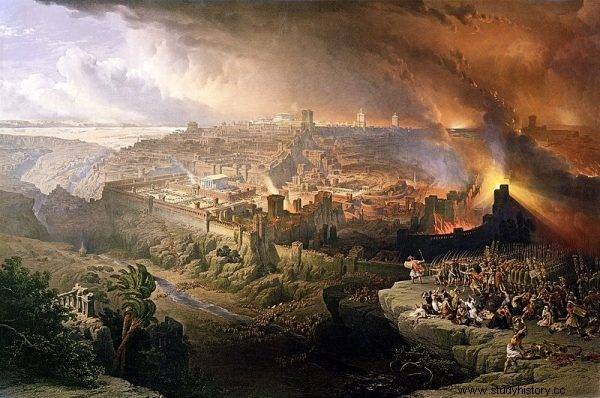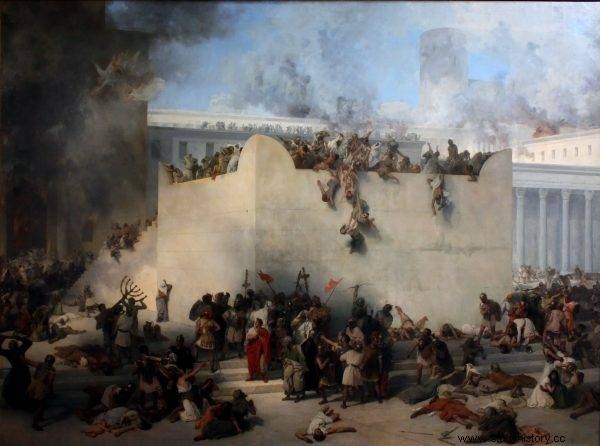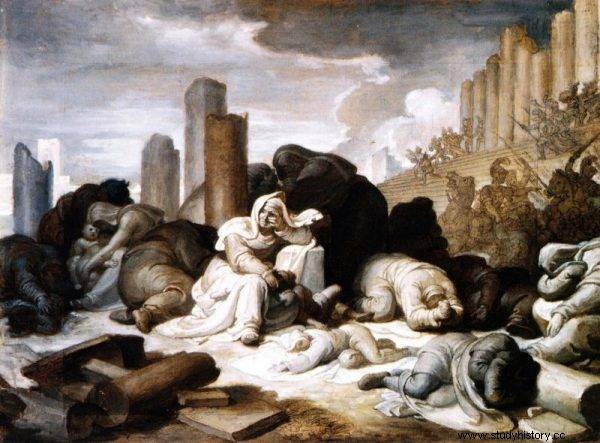They murdered in broad daylight, in noisy places. They killed victims with curved knives - the so-called sica. After all, they left unnoticed. That's how the sicarians worked.
After the death of Herod the Great, tensions in the Jewish land subordinated to Rome grew. Eventually, Judea was transformed into a Roman province. Resistance to the occupant grew. Even in the time of the prefect of Pontius Pilate, there were bloody repressed rebellions in Jerusalem. The state was torn by internal conflicts. They were also hit by an economic catastrophe (including the famine of 40 CE). In 66, after the riots in Caesarea, an uprising broke out, which the historian Josephus Flavius called the Jewish War . The rebels were initially very successful. Sent to suppress the rebellion, the 12th Legion that came from Syria suffered heavy losses. As many as 6,000 were killed legionnaires. The insurgents also captured the golden eagle of the legion.
Roman legionnaires - genocides
A year later, Rome sent the 13th legion to Galilee under the command of the consul Titus Flavius. The occupiers dealt bloodily with the defenders of the fortress of Jotopata. These heroically defended themselves for 47 days. (They were commanded by Josephus Flavius. Later - acquitted by Emperor Vespasian - he described the history of the Jewish war as a Roman citizen). Ultimately, however, as a result of regular sieges and catapult fire, the fortress was destroyed. The Romans broke into the city with the help of a traitor. They slaughtered civilians. 40 thousand were killed people.
Subsequent episodes of the war were marked by equally brutal genocides at the hands of legionnaires, but also by the insurgent resistance of the insurgents. In 68, the Romans captured the Gamal Fortress. The siege lasted for 7 months. The legionnaires once managed to break deep into the buildings, but after fierce street fighting they had to withdraw. Eventually, the resistance weakened due to human losses. After winning Gamala, as much as 5,000 people - residents and zealots (nationalist, anti-Roman insurgent party) decided to commit suicide by jumping into a precipice from a hill.

In 70 AD, the Romans captured Jerusalem.
In 70 AD, the Romans captured Jerusalem. According to Tacitus, as many as 600,000 were to die in the besieged city. people. A large part died of starvation as a result of the Roman blockade. People - including exhausted women and children - were dying in the streets . Those who broke through for provisions and fell into the hands of the legionnaires were crucified. The Jerusalem Temple was sacked and burned.
The final act of brutal pacification of the uprising was the fall of Masada - a mighty fortress on top of a plateau at the edge of the Judean Desert by the Dead Sea. Masada defended itself until 73, besieged by 5,000. legionnaires and 9 thousand. slaves. There were 1,000 defenders inside. In view of the futility of further resistance, the defense commander, Elzear Ben Jair, made a dramatic decision - he made all those locked in the walls to mass suicide. The husbands were to kill the wives and children, then they themselves were killed by the appointed zealots. Only a few people hidden in the sewers survived the mascara. It was the final end of the Jewish uprising.
Sica for traitors
Elzear Ben Jair was a sheicar. He belonged to the most radical faction of the zealots. This political and armed group tried by all means to throw off Roman domination. The zealots combined political and religious views. They recognized that anyone who accepts subjection to Rome denies one God . They also believed that by their struggle they would hasten the coming of the Messiah who would free the Jewish people from suffering. The Sicarius were the camouflaged armed arm of the Zelock party. It should be added that the Jews of that time were strongly divided on the issue of their attitude towards Rome. The submission to the empire was accepted by the Sadducees - gathered around the aristocracy and priests of the Temple of Jerusalem. They also did not resist the Hellenization of society.

photo:Francesco Hayez / public domain. The zealots combined political and religious views. They recognized that anyone who accepted submission to Rome was denying one God.
The Sicarians opposed foreign influences. During the siege of Jerusalem, they elected the chief priest of the Temple of Fanni - a stonemason not at all associated with the priestly caste. Their radicalism towards people considered traitors usually took the form of murder. The assassins' trademark was sica - a curved dagger they used to kill their victims. Josephus Flavius, who from the insurgent commander became a Roman citizen and was himself considered a traitor, wrote this about the methods of fighting by the sicarians:
They murdered people in broad daylight and in the heart of the city. They mingled with the crowd, especially during the holidays, and wearing small daggers hidden under their robes, they galloped with them to their opponents. When they fell dead, the killers joined the vigilant crowd, thus becoming free from suspicion, never to be detected at all.
The first terrorists in history
Flavius accuses the assassins of hypocrisy and false motivation:
For at that time the Sicarians had teamed up against those who would submit themselves to the Romans. They treated them just like their enemies, looting and kidnapping their property and setting their homes on fire. For these people, they said, are no different from strangers, since they so shamefully renounced the freedom for which the Jews had fought so many battles and voluntarily bowed their necks to the yoke of slavery by the Romans. But these speeches were only meant to serve as a veil behind which they wanted to hide their cruelty and greed, as evidenced by their deeds. Because it was those who rebelled with them and waged war with the Romans together, who fell victim to the special atrocities of the Sicarians.
Did the historian write in such a way as to "cleanse" himself of the accusation of collaboration? We don't know that. Certainly - as in any radical organization using violence - also in the ranks of the sycarians there had to be "rotten fruit", i.e. people who killed for satisfaction or benefits - e.g. material benefits.

Sometimes - because of their fighting methods - they are called the first terrorists in history.
Sometimes - because of the methods of fighting - are called the Sicarians the first terrorists in history . It is a catchy slogan, although a far-fetched one. The ancient world did not know the concept of terrorism, and assassination as a method of political or armed struggle existed long before the Jewish war. The Sicarians were after all more insurgents than a specialized group of murderers . The same false myth of professional assassins also applied to the Islamic Assassins (Nizaris) who were over a thousand years later. In fact, rather than trained "killing machines", they were rather a group of doormen - their actions often ended in the death of the bomber.
It is worth adding that in Polish history we also have assassination episodes, very similar to the activities of ancient sycarians. During the January Uprising, daggers were active in Warsaw and other centers, who discreetly, by means of violent actions, murdered collaborators with the administration of tsarist Russia.
